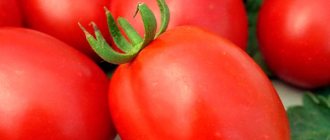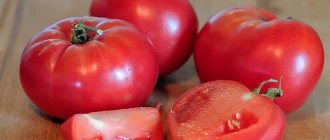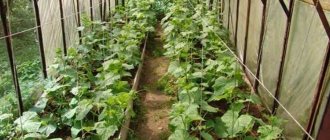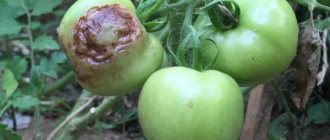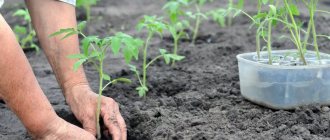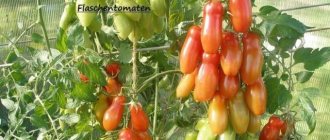All farmers had a wonderful opportunity to meet and enjoy the Octopus tomato tree. A highly productive hybrid can produce up to hundreds of kilograms of fragrant and tasty fruit in 1 season. In 1 season, the harvest in open street beds reaches 12-15 kg. You just need to not dream, but plant.
| Height | Landing location | Ripening time | Fruit color | Fruit size | Origin | Fruit shape |
| Tall | Greenhouse, Open ground | Mid-season | Reds | Average | Hybrid | Round |
Characteristics of the variety
Thanks to the Japanese breeder, who at the end of the 20th century developed the hybrid Octopus F1, it became possible to grow not only bush forms, but also tomato trees
By the 21st century, the variety was patented by the agricultural company Sedek, after which it appeared in the State Register of Russia. They developed a special technology for growing crops, taking into account the climate of our area. Now it can be planted even in Siberia.
Bushes
The description of the tree is as follows:
- height - up to 5 m;
- crown diameter reaches 50 m²;
- oval-shaped leaves;
- Lifespan is up to 15 years. A distinctive feature is that new shoots appear regularly.
():
All tomatoes by their biological nature are perennial plants. But in temperate conditions they are grown as an annual crop. If an ordinary bush tomato variety is grown at home in a tub or pot at a constantly high positive temperature (+22-25 degrees), the tomato will grow and bear fruit for several years.
Fruit
About 6-7 fruits are formed on one brush. Their shape is round. The size is medium, weight is about 150 g. Color varies from yellow to red. The pulp is juicy, aromatic, with a sweet aftertaste.
One Sprut tomato tree can bear up to 15 centners of fruit.
The harvest is used for making sauces, tomato juice, and canning. They are stored for a very long time; at home they may not spoil for 5-7 weeks. They tolerate transportation well.
Octopus for a greenhouse
In sheltered spaces, the tomato tree shows itself completely differently. It “climbs” upward, occupying the upper tiers of the greenhouse, freeing the lower ones for the cultivation of other crops. Having planted a couple of bushes in a greenhouse, the bottom can be used for onions, or spicy, shade-tolerant herbs.
The main task when growing a tree remains supports and fixing bases.
Each newly formed stepson must be carefully tied up and launched vertically. When growing this tomato, you need to think in advance about how exactly you will fix the tomato branches. Experienced gardeners pre-stretch the mesh under the ceiling of the greenhouse, and then just feed the shoots into the hole in the mesh. The shoots lie on the net, lowering down their set and ripened fruits.
At the same time, systematic work with the root system continues.
Growing in a greenhouse
A tomato tree can grow to gigantic sizes, so the greenhouse must be large.
To grow a healthy crop in greenhouse conditions, the soil must contain nutrient solutions - hydroponics.
():
Hydroponics is used only in industrial greenhouses; this method is practically not available to ordinary gardeners. A regular ground greenhouse is the simplest and most suitable option.
The plant is planted in autumn. The greenhouse should be equipped with heating and warm-colored lighting. Proper growth requires at least 12 hours of light.
Tomatoes should be wintered at a temperature of at least 20 ℃, and in summer no more than 26 ℃. If the technology is not followed, the tree will grow no more than 2 m. To stop the immense growth, a mesh is made under the ceiling, this forces the crop to spread directly over it.
():
To become a “tree”, i.e. To grow a tomato to a height of 5-10 m, you need the appropriate dimensions of the greenhouse, and most importantly, the greenhouse must be heated. In a regular greenhouse, the height of plants of this variety will not exceed 2-2.5 m, and the duration of fruiting will not exceed the end of October. With the onset of severe cold, the plant dies.
The mother liquor is used as fertilizer. To prepare it you will need:
- 200 g ammonium nitrate;
- 500 g potassium;
- 0.9 mg lemon iron;
- 550 g of superphosphates;
- 300 g boric acid;
- 300 magnesium;
- 0.2 mg manganese sulfate.
After this, 1 liter of solution is diluted with 100 liters of water and mixed. Growing seedlings begins in August. A month later, a solution is added to them and moistened several times a day. After 2 months from the emergence of seedlings, the seedlings are placed in a large container and air supply tubes are connected to them and covered with a lid.
Planting seedlings
Growing the octopus tomato tree at the seedling stage should be done in a warm and bright room.
Around April 15, the seedlings will be ready to be transplanted to a permanent location.
There they will gradually increase in size, grow and become like a tree.
Seedlings can be planted only after more or less warm weather has established itself without night frosts.
Preparing the site
It is recommended to choose a windless area. The place should be well lit.
Fertile soil will promote active growth and development of the hybrid.
The best option is loamy soil without stagnant water.
Note! The composition of the soil plays a huge role. The rate of development of the tomato tree depends on it. Remember that the soil must have humic acids.
Soil preparation
If the soil does not meet all the criteria necessary for normal development, it is recommended to add compost to the soil.
For this purpose, they also purchase a special substrate suitable for growing tomatoes.
During planting, a small handful of wood ash and azophosphate is added to each hole.
Until warm weather sets in outside, it is better to cover the seedlings at night with special material or film.
Planting
By the time the seedlings need to be planted in a permanent place, they should reach a height of 15 to 30 cm and have 5-7 true leaves.
Planting pattern: make a distance of at least 150 cm between the holes.
This distance is necessary, as the tree will grow to an impressive size.
Each plant should not interfere with the other and should not block sunlight.
Before planting, you need to treat the roots with iodine solution.
1 bottle is dissolved in a bucket of water and the roots are placed there.
When planting, the plant is buried 20 cm. For active root growth, some gardeners advise trimming them a little.
The easiest way to grow a hybrid is on a trellis. Wooden stakes or a special frame are also suitable for this.
The devices must be at least 2 m high and installed immediately after planting the seedlings.
Growing in open ground
The soil for growing in open ground should have a pH of 5.5-6.8, be loose and enriched with organic matter, and contain clay or sand. The landing site should be well lit and protected from winds. The distance of groundwater from the roots should be at least 2.5 m.
Before you sow the seeds, they need to be germinated. To do this, take a damp paper napkin and place seeds inside. Place on a plate and wrap in cellophane. Store the seeds in a warm place and water as the napkin dries.
In 4-5 days they will germinate and be ready for planting in the ground. It must also undergo a little preparation: turf soil, river sand or clay and peat are added to the soil in a 1:1 ratio. Next, fill it with a solution of urea, potassium sulfate, superphosphate and water.
Special containers for seedlings
Growing technology
For open ground, there is a special seed planting scheme, a description of which will help the gardener.
- For planting, use small containers with through holes at the bottom. Treated soil at room temperature is placed in them.
- Water the soil with water that has stood at room temperature to speed up the appearance of sprouts.
- The seeds are poured into the soil in an even layer and the soil is compacted.
- Place the boxes in polyethylene to keep moisture inside for as long as possible.
- Send to a warm place until June, periodically checking the soil for moisture. As the plant grows, it needs to be transplanted into larger containers.
- In June, all stepsons, buds and damaged branches are removed.
- Dig small holes and lower the sprouts without plunging the leaves underground.
- The top of the main trunk is pinched to prevent it from growing.
- The distance between seedlings should be at least 1.5 m.
Soil nutrition is the basis for success
When considering the question “How to grow Octopus tomatoes,” you need to be aware that the yield of this tree is measured not in kilograms, but in buckets, and the removal of nutrients from the soil is so high that in their absence, the harvest is simply not possible. Both the seedling soil and the place of permanent growth should consist of a fresh peat-humus base. For each bucket of soil mixture add 2 tbsp. l. superphosphate, 2 tbsp. l. ammonium nitrate, 1 tbsp. stove ash.
Experienced vegetable growers prepare such a soil mixture in the fall, giving it the opportunity to “mature” and balance. During ripening, the layers are repeatedly turned over, and only by spring it becomes ready to grow a huge crop.
Problems during cultivation
With the onset of autumn, tomatoes are in danger of rotting. This scourge comes with wet weather, damaging the fruit and plant from the inside. It appears as brown spots and progresses very quickly. In open ground conditions it is less common than in a greenhouse.
The crop absorbs water unevenly. The best prevention is timely and moderate watering, after which the soil is loosened. Mulch can prevent the development of rot: in the greenhouse you need to ensure that the temperature does not rise above normal. Excess fertilizer can also be a problem. In the fight against blossom end rot, a solution of calcium nitrate is used.
Pests
When growing Octopus tomatoes, gardeners often encounter the appearance of a caterpillar. It devours not only the leaves, but also the fruits of the tree from the inside. As a fight, you can turn to folk remedies.
- Wormwood decoction. Pour 0.5 kg of wormwood into 1 bucket of water and boil for half an hour. Leave for 2 days, strain and dilute with water 1:10 and add 1/3 of the soap. Spray twice a month.
- Tobacco infusion. Boil 1 bucket of water and add 0.3 kg of fine tobacco. Leave for 24 hours and add soap. Spray until the pest disappears.
():
If you want to really exterminate pests, use real products - insecticides. Many gardeners are afraid to use them, resorting to “folk remedies” that no longer “work”. The main thing is to use chemical insecticides in the most vulnerable phase of life for these insects, then you won’t have to spray a lot and often. The caterpillars of the cotton bollworm (it is the one that “makes holes” in tomatoes) have the most vulnerable phase—the caterpillars that have just hatched from the eggs. Clutches of these eggs can be found on the surface of the fruit. When a brown dot appears in these white eggs, this means that in 1-1.5 days a caterpillar will emerge from the eggs. It is at this time that the plants need to be treated. Otherwise, the emerging caterpillars gnaw through the fruit and penetrate into it, making further processing pointless.
Aphids may appear; sprinkling the foliage with cold water or a solution of 0.3 cayenne pepper, 1/3 laundry soap and 10 liters of water helps.
Diseases
Those who have already planted this variety say that it has quite strong immunity to various kinds of diseases, but in some cases it can be affected by late blight. Its symptoms are similar to rot, but it is more difficult to get rid of because... it's a fungus. It spreads quickly and affects the fruits and trunk of the tree, gradually reaching the root.
Turn to traditional methods: a decoction of wormwood is considered effective. If the disease progresses, you should resort to the following drugs: Alyette or Quadris. Aliette is sprayed up to 5 times a year, and the crop is harvested no earlier than 5 weeks after treatment. To do this, use a 0.5% solution at a rate of 3 kg/ha.
Problems you may encounter
Pests
Whitefly and cutworm caterpillars cause trouble for tomatoes, especially young bushes. Irrigation solutions and sprays are used to protect shoots. Among the effective products are “Profi”, “Decis”, “Aktofit”. Folk recipes - a solution of cayenne pepper, soap, and salt - provide effective benefits against aphid infestations.
Rotting plants
In slush and high humidity, you should be wary of rot. Often rotting occurs due to improper watering. The lesion can involve roots, fruits, and shoots. It occurs with massive infection of the entire plant.
Tomato care
Be sure to tie up the bushes
Proper care affects yield, fruit quality and disease resistance. The following rules will help you grow Octopus tomatoes:
- The culture does not need pinching, so it cannot be carried out;
- feed with organic and inorganic mineral fertilizers 3 times a week;
- a tree can grow significantly over a season: to prevent this, its top is cut off;
- water the tree regularly and in the right amount;
- dried leaves must be removed to avoid the development of diseases;
- high branches are tied up, you can make a support from a stick.
To protect the roots from the development of diseases, they are treated with an iodine solution. It is prepared from 10 liters of water and 1 bottle of iodine. Water the plant with the solution once. During the first days after planting, seedlings need abundant watering. The soil moisture level should be at least 60%; irrigate only with water at room temperature.
To fertilize the soil, use the following composition: compost and soil in equal quantities fill the container 1/3 full. Fill with water and leave for a day. Feed from July until fruit harvest 2-3 times a week.
It is better to resort to hydroponics - a special technology thanks to which the plant grows not directly in the soil, but in an artificial environment enriched with micronutrients. This significantly increases the yield and sustainability of the tree.
Description and characteristics, yield indicators
Sprut tomatoes are indeterminate, for this reason their side shoots are especially strongly developed. The octopus is not limited in growth.
The hybrid can be classified as late in terms of fruit ripening. From the appearance of tomato sprouts to harvest, 120-130 days pass.
The yield is 6-8 kg per bush at a time. The fruits on the bushes appear in racemose clusters, each with at least 5-6 tomatoes. The brushes are placed on the bush in the spaces between every three leaves.
The hybrid has good resistance to heat and is practically not susceptible to most known tomato diseases. The tomato is resistant to rot of any kind, tobacco mosaic and powdery mildew, and is immune to verticillium.
Each tomato is endowed with excellent taste, meaty, large and juicy. The weight of one fruit can reach 130 g. The tomatoes are round in shape, slightly flattened, and are stored for a long time after picking.
Harvesting
The fruits ripen after 3 months. The first ones appear after 2 years of life and bear fruit annually. They are picked when they just start to turn red. You can miss the moment of full ripening and lose most of the tomatoes if you delay picking.
():
Fruits appear on the Sprut tomato variety 60-90 days after planting the seedlings, as with most conventional varieties, but fruiting in a heated greenhouse continues for several years.
Greenish fruits can ripen at home on a windowsill, depending on ripeness - this will take from 1 to 2 weeks. It is advisable to store Octopus in a warm place; in the cold they deteriorate faster.
What problems may arise
Rot - often appears on bushes in open ground. Carefully monitor the humidity and frequency of watering the tomato octopus.
Yellowed leaves - if no visible plant disease is detected, then this is a sign of magnesium deficiency. Apply fertilizers with this component.
Curling of leaves is either aphids or too low temperatures at night.
Aphids - when fighting them, it is enough to spray the leaves with cold water or a soap solution familiar to people, which fights this scourge well. The tomatoes will not be harmed.
Caterpillars - to stop their spread, it is better to collect them by hand. Plant dill nearby, the smell of which these insects do not like.
Mosaic patterns on the leaves, their swelling is a virus. Immediately remove affected leaves and tomatoes nearby, and then thoroughly clean the tools and wash your hands. After removing diseased leaves, do not try to touch healthy bushes with the same hands and tools.
Varieties of tomato tree
Sprut F1 tomatoes include several varieties that differ from each other in some characteristics.
- Rotamer is a salad variety that is used not only in classic recipes. Desserts are often made from it; the fruit has a pronounced sweet aftertaste.
- Inka Gold - apricot tomatoes: both in taste and color they resemble this fruit.
- Octopus Slivka F1 is a mid-early hybrid that brings a rich harvest (you can get up to 10 kg/m²).
- Solid Gold is the closest tomato to the standard taste, but the shape is non-standard - ovoid.
Advantages and disadvantages, features, differences from other varieties
If we talk about the possibility of growing the Octopus tomato and its varieties in the form of a tree in a two-year culture, then here, perhaps, there is nothing to compare the Octopus with; we can say that it is a unique hybrid. However, for normal conditions (standard greenhouse or unprotected soil), the main indicators of the hybrid are not much different from hundreds of similar tomatoes. Its advantages can be considered:
- versatility of crop use;
- high productivity;
- very good disease resistance;
- drought resistance, resistance to sudden changes in conditions;
- long shelf life of fruits and excellent transportability.
The disadvantages are:
- inability to harvest the entire harvest under standard conditions (the last fruits to set do not have time to ripen);
- sharp dependence of yield on soil fertility;
- the unattainability of the declared characteristics of the hybrid under normal conditions.
In principle, considering Octopus as a possible option for growing in a regular greenhouse, we can say that it is nothing special. Indeed, if it is not possible to grow a tomato tree, then there are several hundred indeterminate varieties and hybrids of tomatoes comparable in most respects to Octopus and even superior to it. After all, he is not outstanding, in fact, in any respect. Its main declared characteristics are a mid-season salad variety. There are many such varieties, and almost half of them are characterized not by good, like Octopus, but by excellent fruit taste. Many of them have similar physical parameters of the fruit (shape, color, size) and yield.
The peculiarity of the Octopus tomato is only the potential opportunity to grow it in the form of a tree and obtain a harvest in a two-year cycle. This requires special greenhouses with constant heating and good lighting, nutrient soils and hydroponics, and automatic watering systems. So for an ordinary summer resident, the Octopus tomato can be of only theoretical interest: you can plant it, but you can’t realize all its potential.
Video: Octopus and Octopus cream tomatoes in a greenhouse
Advantages of Octopus F1 tomatoes
In addition to tasty fruits and intensive development, the advantages of this variety include:
- Good branching.
- Fruiting from July to September.
- Uniform distribution of fruits according to taste. Tomatoes collected at the top of the bush are no different from tomatoes picked at the bottom.
- Adaptability to high humidity, cold and heat.
Other Octopuses and reviews from gardeners
In recent years, other hybrids with the same name have appeared on the market and become even more popular.
The main reason for their popularity among the people is their earlier ripening. Tomato Octopus Cream F1 can be safely classified as a mid-early tomato; mature fruits appear within 100-110 days after germination. In addition, it is characterized by very beautiful fruits, almost the same shape and size, with glossy skin, which look very attractive on the bushes. Multi-colored Octopus cream retains all the same characteristics, differing only in the color of the fruit.
The Sprut Cherry F1 tomato was even included in the State Register of Russia in 2012. It is also distinguished by earlier ripening periods. In addition, it is even more productive than the usual Octopus. At least, when grown under normal greenhouse conditions, you can get up to 9 kg of tomatoes from one bush.
Comment! The Octopus raspberry cherry tomato F1 appeared relatively recently and differs from its cherry counterpart only in the beautiful crimson color of the fruit. All other characteristics are completely the same.
Since, in recent years, gardeners have apparently come to terms with the fact that it is too difficult to grow a tomato tree from Octopus, reviews of these hybrids have become more optimistic. Many people still value the yield, taste and great vigor of tomato bushes.
Olga, 34 years old, Biysk
I planted Octopus Cherry last year and just didn’t know what to do with the abundance of tomatoes. The bushes grew medium, about 1.8 meters in height. I liked the taste of tomatoes, they were so sweet. But this year I will reduce the number of bushes by half, since they are very productive, I don’t need so many.
Tatyana, 42 years old, Moscow region
Our whole family likes Sprut Cream both in taste and in terms of yield. We have been growing it for four years now. But I also tried to grow the common Octopus several years ago, but I didn’t like it at all. Maybe the seeds were fake.
Irina, 55 years old, Yeisk
I have been planting Octopus cream for several years in a row, everyone likes them. The grandchildren eat them straight from the garden instead of sweets. And adults like them in salads and salty - pickled. We grow them in open ground, we stretch several rows of wire and it stretches up to three meters, and then grows even further on the other side. Its stems are flexible, it looks almost like a vine, very beautiful. I think next year I will plant it near the gazebo - it will be beautiful.
Evgeniy, 39 years old, Tambov
I grew Octopus several years ago. I planted 5 seeds and constantly transplanted two of them into large containers and constantly fed them with vermicompost. So by the time they were planted in the greenhouse, they were already growing in my 10-liter buckets and were already getting ready to bloom. I really got a huge harvest from these bushes - up to 10 kg from each. The rest, which grew like ordinary tomatoes, were no different. So if you really want to, you can grow anything.

